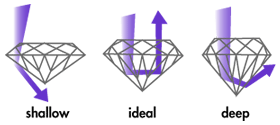Diamond Grading - Cut Grade and the Ideal Cut
The beauty of a diamond resides not only in a favorable body color, but more importantly in its optical properties, in particular the high refractive index and color dispersion. Only when precisely calculated planes and angles are used in the cut of a diamond does the stone attain its greatest possible beauty.
The way a diamond is cut, its width, depth, roundness, size and position of the facets determine the brilliance of the stone. Even if the color and clarity are perfect, if the diamond is not cut to good proportions, it will be dull and less impressive to the eye.

The Ideal Cut Round Brilliant Diamond
The earliest guidelines for diamond cutting were based more on aesthetics than science, but in 1900 the round brilliant had evolved into something very close to its current form. In 1919, Marcel Tolkowsky, a member of a Belgian diamond cutting family, published a short paper entitled Diamond Design. This was the first analysis of diamond cutting based on modern science theories of light behavior.
Despite the fact that Diamond Design was first published in England, Tolkowsky’s design is often called the “American Ideal Cut” because U.S. cutters were the first to produce it in significant quantities. In the 1950’s, AGS adopted Tolkowsky’s model as its standard for grading cut. The only modifications to the basic design were establishing limited ranges for table size, crown height, pavilion depth and girdle thickness. In 1955, the updated model was renamed the AGS Ideal Cut.
The demand for Ideal cut diamonds has substantially increased and today numerous cutters around the world are producing designs loosely referred to as “Ideal Cuts.” The standards for these “ideals” vary significantly, and as a result, the ability to recognize and evaluate diamond cutting variations is even more important today. The popularity of “ideal cuts” and the increased consumer demand for verification of this quality factor, were among the primary reasons for establishing the AGS Laboratory (AGSL). Opened in 1995, the lab has grown quickly because it is the only U.S. facility that addresses cut grading in Diamond Quality Documents. (GIA Gem Trade Laboratory), the primary industry source for diamond quality documentation does not address the issue of cut grade in its reports.
American Gem Society (AGS)
The American Gem Society (AGS) Diamond Grading Laboratory uses a cut grade system that assigns diamonds a cut grade as a number between 0 and 10. The AGS Cut Grade reflects the impact of 3 key elements on a diamonds beauty and value:
proportions -- symmetry -- polish
Proportions are the sizes and angles of the diamond’s main parts. Symmetry is the balance and evenness of its faceting and shape. Polish refers to the diamond’s surface quality, including the presence or absence of characteristics such as abrasions, scratches, nicks and polish wheel lines
The AGS Ideal 000 (triple zero) cut grade represents the very best in diamond cutting.
AGS 000 is only assigned to a diamond in which correct proportions, precise symmetry and fine polish are combined to produce an optimum display of brilliance, scintillation and dispersion. The impression is a harmonious balance between the physical dimensions of the diamond and the optical components of its beauty.
As diamonds fall into grades further from 0 (ideal), their relationship to beauty begins to diminish. For example, a diamond with a cut grade of 1 or 2 (very fine cut) are very close to 0 in appearance. A cut grade 5 diamond has variations that detract significantly from overall appeal. It may appear somewhat “washed out” or slightly dark through the center. Cut grades 10 are the worst examples of proportioning, symmetry and polish; so they have little visual “life.”